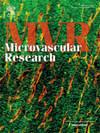A cost-effective vessel-on-a-chip for high shear stress applications in vascular biology
IF 2.7
4区 医学
Q2 PERIPHERAL VASCULAR DISEASE
引用次数: 0
Abstract
The vascular endothelium is constantly subjected to hemodynamic forces, including tangential shear stress, which are crucial for maintaining vascular homeostasis. Pathological shear stress levels, such as those observed in pulmonary arterial hypertension (PAH) or atherosclerosis, disrupt this balance, driving vascular remodeling and endothelial dysfunction. Current microfluidic platforms for studying these conditions are limited by high costs, excessive reagent requirements, and non-physiological channel geometries. Here we introduce a novel microfluidic chip system, a Nylon Vessel-on-a-Chip (NVoC) which represents a cost-effective and straightforward fabrication platform that eliminates the need for specialized equipment and enables a physiologically relevant round channel geometry. The NVoC was fabricated using Polydimethylsiloxane (PDMS) and nylon threads, with surface activation achieved through polydopamine and collagen-I coating, enabling robust endothelial cell (EC) attachment and long-term culture. Immortalized endothelial colony-forming cells (iECFCs) and human umbilical vein EC (HUVECs) were used to optimize and validate the platform, demonstrating its compatibility with high shear stress conditions (up to 90 dyne/cm2) and various molecular biology techniques, including RT-qPCR, Western blotting, and immunofluorescent staining. With fabrication costs six times lower than commercial alternatives and overall experimental costs reduced threefold, the NVoC offers the ability to expose endothelial cells to physiological and pathological shear stress levels in a reproducible, accessible, and scalable manner. Its versatility and affordability make it a valuable tool for investigating shear stress-related mechanisms in microvascular diseases, particularly PAH, with potential applications in drug discovery and translational research.

一种具有成本效益的血管芯片,用于血管生物学中的高剪切应力应用
血管内皮不断受到血流动力学力的影响,包括切向剪切应力,这对维持血管稳态至关重要。病理性剪切应力水平,如在肺动脉高压(PAH)或动脉粥样硬化中观察到的水平,破坏了这种平衡,驱动血管重塑和内皮功能障碍。目前用于研究这些条件的微流控平台受到高成本、过多试剂需求和非生理通道几何形状的限制。在这里,我们介绍了一种新的微流控芯片系统,尼龙容器芯片(NVoC),它代表了一种具有成本效益和直接的制造平台,消除了对专门设备的需求,并实现了生理相关的圆形通道几何形状。NVoC由聚二甲基硅氧烷(PDMS)和尼龙线制成,通过聚多巴胺和胶原- i涂层实现表面激活,使内皮细胞(EC)附着和长期培养稳定。利用永生化内皮细胞集落形成细胞(iecfc)和人脐静脉细胞集落形成细胞(HUVECs)对平台进行优化和验证,证明其与高剪切应力条件(高达90 dyne/cm2)和各种分子生物学技术(包括RT-qPCR, Western blotting和免疫荧光染色)的兼容性。NVoC的制造成本比商业替代品低6倍,总体实验成本降低了3倍,能够以可复制、可获取和可扩展的方式将内皮细胞暴露在生理和病理剪切应力水平下。它的多功能性和可负担性使其成为研究微血管疾病(特别是多环芳烃)中剪切应力相关机制的宝贵工具,在药物发现和转化研究中具有潜在的应用前景。
本文章由计算机程序翻译,如有差异,请以英文原文为准。
求助全文
约1分钟内获得全文
求助全文
来源期刊

Microvascular research
医学-外周血管病
CiteScore
6.00
自引率
3.20%
发文量
158
审稿时长
43 days
期刊介绍:
Microvascular Research is dedicated to the dissemination of fundamental information related to the microvascular field. Full-length articles presenting the results of original research and brief communications are featured.
Research Areas include:
• Angiogenesis
• Biochemistry
• Bioengineering
• Biomathematics
• Biophysics
• Cancer
• Circulatory homeostasis
• Comparative physiology
• Drug delivery
• Neuropharmacology
• Microvascular pathology
• Rheology
• Tissue Engineering.
 求助内容:
求助内容: 应助结果提醒方式:
应助结果提醒方式:


